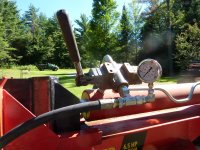A little mis imformation here:
most electric motors spin a at 1750 rpm I believe
Actually, its about 50/50 as far as popularity. 1800rpm or 3600rpm. But you buy for the application. You can even get 1200rpm motors (6 pole)
. if you use a double speed pulley system you will need twice the power. so your back where u started...
Ditto what gordon said. Power remains constant regardless of speed. Its only the torque that changes.
I would not use that motor. Compressor duty motors fudge the ratings a bit. With a FLA of only 15, its more like a 3hp motor. And with only a 1.0 SF, not gonna last long if/when it ever spikes a tad above. the thing with electric motors, they dont like to stall. They just keep drawing the amps till they fry. No way to tell without an overload, or watch an amp clamp, or wait till its too late.
Here are the lovejoys. The motor above has a 5/8 shaft.
5/8" L-099 JAW COUPLING HALF
If your pump has a 1/2" shaft, you will need this other half.
1/2" L-099 JAW COUPLING HALF
Should only need one to fit the electric motor. No need to spend $$$ on both halves and a spider. And unless they changed something, it should be an L090 series. Which is also compatible with the L095's. The 095's are just a little thicker, but take the same spider and you can mix and match L090's with L095's
Now....to the OP:
Forget about the 115v. No way to do it. For a 220v single phase motor, you will need a TRUE 5hp motor like the leeson ajmaxham listed with a FLA of 20.8 if you want it to last.
We have the same splitter, converted to electric. (well actually the 27t version but same pump). using a 182 or 184 frame motor, you should be able to come off the front vertical part of that motor "box" and be darn dear perfect in alignment. We used two pieces of 2x2x1/4 angle iron. A c-faced mount would be easy as well. More than one way to do it.
For our motor, we are using a 3hp 3-phase with a VFD. I would have liked a 5hp motor, but of the 40 some motors I have, none of the 5hp motors were 3600RPM. But I have about 6 3HP motors that are. And the VFD wont run a 7.5. So my options were to run a 5HP @ 120hz, or a 3hp and possibly overwork it occasionally. FLA on it is 8.0 with a SF of 1.15. And extending the ram all the way and holding it till it pops the pump relief (max pressure) and it was drawing ~11A. But while splitting, it rarely went above 8, and when it did, it only spiked 9 just briefly. So still within the SF of the motor.
So why am I telling you this.....3 phase motors are usually cheaper than single phase. And pretty easy to come by on ebay. you can get a VFD that will run a 5hp 3 phase for ~$230, and is nice for its adjust-ability. So when motor shopping, keep that in mind. That if you can find a 3-phase for ~$200 less than a single, it might just be worth it.

